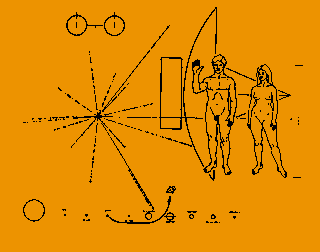The STI workshop will try to formulate how we will tell the aliens about the human race * Scientists and artists will gather on Sunday and Monday of the week to tell the aliens about morality and human altruism

The gold plate attached to the Voyager 2 spacecraft, which Dr. Carl Sagan helped prepare. This time the message will be much more complex
Twenty scientists, artists and philosophers will gather on Sunday and Monday (March 23-24, 2003) in Paris to discuss how best to tell aliens about altruism. This is the second in a series of workshops where they try to explain what it means to be human to creatures that came from a foreign civilization. Last year this meeting discussed ways to explain to aliens what human beauty and aesthetics are.
Altruism is the next step because it is an idea that crosses cultures. It can be expressed in mathematical ways general enough for other beings to understand. The intention is to explain our humanity, not just our nobility, explains the chairman of the gathering, psychologist Douglas Vakoch from the STI Institute in Mountain View, California.
Previous attempts to convey the message, such as the plaque on the Voyager spacecraft reflecting the positive side of humanity, he says, "there is no trace of poverty, or wars, or the atomic mushroom cloud. We are trying to start a real dialogue about the way we describe the entirety of the human experience."
Any message, Vakuch says, should take into account studies of animal and human behavior that show that a degree of self-sacrifice serves selfish needs. Good deeds are often done to help loved ones, in terms of future gain and loss for good.
The workshop will try to build some kind of message, maybe an image and not just a series of data would be more appropriate, says computer scientist William Edmondson from the University of Birmingham in the UK. "We are talking about a postcard - any sequence of symbols is so limited by culture that it will not be appropriate." Another option is to send an interactive message. For example, we could broadcast a computer program that plays the prisoner's dilemma, where the attempt to cheat harms the benefits of sharing.
However, the ST Institute has no intention of really sending a message. "The question of whether we should broadcast at all, and what we should say requires so much work that it is still too early to do so now," says Vakuch.
